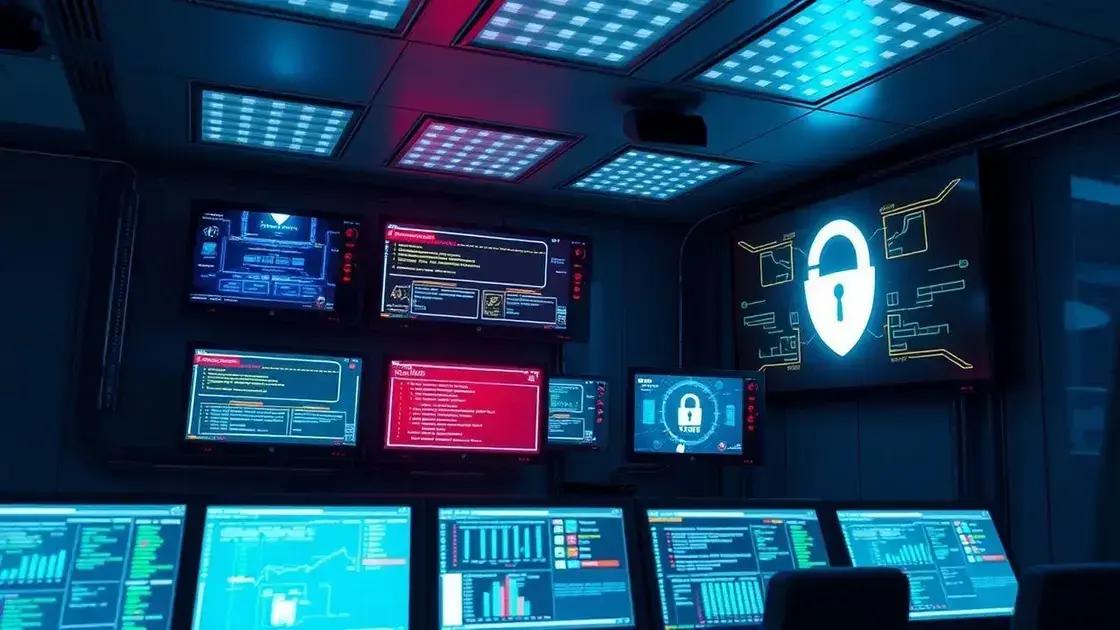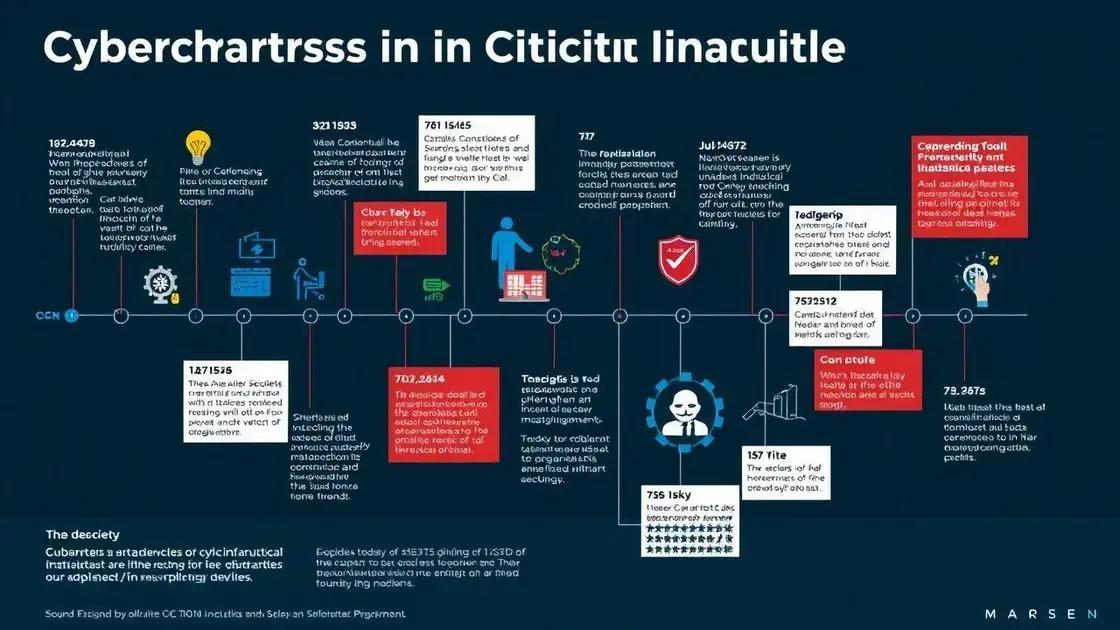Electric grid cyberattack investigations: what you need to know

Electric grid cyberattack investigations focus on identifying vulnerabilities and implementing strategies to enhance cybersecurity through collaboration between government and industry, alongside employee training and regular assessments.
Electric grid cyberattack investigations are becoming increasingly important as threats evolve. How prepared are we to protect critical infrastructure from cyber threats? Let’s explore the landscape together.
Understanding the threat landscape of electric grids
Understanding the threat landscape of electric grids is essential as cyber threats continue to evolve. Electric grids are critical to our daily lives, powering homes and businesses alike. Protecting them is a top priority for governments and organizations.
Types of Cyber Threats
Various cyber threats target electric grids. One prevalent threat is malware, which disrupts operations or gains unauthorized access. Another significant threat comes from phishing attempts, where attackers try to trick employees into revealing sensitive information.
- Malware attacks can disturb grid operations.
- Phishing attempts manipulate staff for sensitive info.
- DDoS (Distributed Denial of Service) attacks overwhelm systems.
- Insider threats from employees can cause data breaches.
These threats highlight the importance of strengthening cyber defenses in electric grid systems. Recent case studies show how a single breach can affect thousands. In many scenarios, threats are not just external; they can stem from insiders who have legitimate access.
Common Vulnerabilities
Electric grids often have vulnerabilities that can be exploited. Aging infrastructure may lack modern security features, making them easy targets for cyberattackers. Furthermore, inadequate employee training can lead to errors that jeopardize security systems.
- Outdated software increases risk.
- Poor training can lead to accidental breaches.
- Unsecured IoT devices can provide entry points for attacks.
Addressing these vulnerabilities is crucial for ensuring the safety and reliability of electric grids. Understanding potential threats and weaknesses allows utilities to develop better defenses. Proactive measures, such as regular updates and employee training, play a significant role in this process.
Finally, as we adapt to new technologies, the threat landscape will change. Staying informed and vigilant is the key to safeguarding our electric grids against emerging cyber threats.
Key cyberattack case studies in recent years

Key cyberattack case studies in recent years provide valuable insights into the evolving tactics used by attackers. These cases help us understand the vulnerabilities within electric grids and other critical infrastructures. They also highlight the importance of having robust cybersecurity measures in place.
2020 SolarWinds Attack
In late 2020, a significant breach was discovered involving SolarWinds, a company that provides IT management software. Attackers used malicious code in updates to compromise organizations worldwide, including various government agencies. This incident raised awareness about supply chain vulnerabilities and the far-reaching impact of cyber threats.
- Compromised updates allowed attackers to infiltrate organizations.
- Major companies and government agencies were affected.
- This breach highlighted the risks of third-party vendors.
The fallout from the SolarWinds incident demonstrated that the threat landscape continues to expand and that the consequences of cyberattacks can be severe. Organizations are now more aware of the need for continuous monitoring and proactive response strategies.
Colonial Pipeline Ransomware Attack
In May 2021, the Colonial Pipeline experienced a devastating ransomware attack that disrupted fuel supplies across the East Coast of the United States. Attackers encrypted company data and demanded a ransom to restore access. The company responded by paying the ransom, igniting discussions about defense against ransomware threats.
- The attack caused widespread fuel shortages.
- Ransom payments raise ethical and economic questions.
- Critical infrastructure vulnerabilities were exposed.
This incident underscored how ransomware can target essential services, making it crucial for organizations to enhance their resilience. By learning from such case studies, companies can develop better incident response plans and strengthen their cybersecurity protocols.
Case studies like these reveal the necessity of collaboration among businesses, government agencies, and cybersecurity professionals. A united front can help combat emerging threats and protect vital services from future attacks.
Preventive measures and best practices for utilities
Preventive measures and best practices for utilities are crucial in safeguarding electric grids against cyberattacks. These practices not only protect sensitive data but also ensure continuous electricity supply. By implementing effective strategies, utilities can enhance their security posture.
Regular Security Assessments
Conducting regular security assessments is a fundamental practice. Utilities should evaluate their systems for vulnerabilities. Penetration testing can reveal weaknesses that need to be addressed.
- Assess systems for known vulnerabilities.
- Perform penetration tests to identify potential weaknesses.
- Develop a routine schedule for assessments.
Frequent evaluations help utilities stay ahead of emerging threats. Detecting potential weaknesses early on allows for timely mitigation efforts. Additionally, a proactive approach ensures continued compliance with regulations.
Employee Training Programs
Educating employees about cybersecurity threats is vital. Training programs should cover topics like phishing, social engineering, and safe internet practices. Employees are often the first line of defense.
- Conduct workshops to raise awareness about phishing.
- Teach staff how to recognize suspicious activities.
- Encourage a culture of security within the organization.
By empowering employees with knowledge, utilities can reduce the likelihood of successful attacks. An informed team is better equipped to handle potential threats.
Further strengthening defenses involves implementing strict access controls. Limiting access to sensitive information based on roles minimizes potential risks. Regularly updating software and systems is another best practice that utilities must adopt. Outdated systems can offer easy entry points for cybercriminals.
Collaborating with cybersecurity experts can enhance security measures. Working alongside specialists can provide insights into the latest threats and protective strategies. Overall, a combination of technical solutions and human awareness is key to mitigating risks and ensuring a resilient electric grid.
The role of government and industry in cyber resilience

The role of government and industry in cyber resilience is vital for protecting critical infrastructure like electric grids. Collaboration between these entities strengthens defenses against cyber threats. Governments set regulations and standards, while industries implement these protocols effectively.
Government Regulations and Standards
Governments play an essential role by establishing regulations that mandate security measures. These regulations often require utility companies to follow specific cybersecurity frameworks. For instance, the NIST Cybersecurity Framework provides guidelines for managing cybersecurity risks.
- Governments establish baseline security requirements.
- Regulations promote transparency and accountability.
- Compliance ensures readiness against threats.
By enforcing these standards, governments help create a unified defense strategy. Consistent regulations reduce vulnerabilities and ensure that all players are prepared to respond to potential attacks.
Industry Partnerships
Industry stakeholders must work together to share information about threats and best practices. Collaborating through industry groups can facilitate knowledge sharing, ensuring everyone is aware of emerging threats and effective defenses.
- Partnerships enable sharing of real-time threat data.
- Joint initiatives enhance research and development in cybersecurity.
- Collaborative drills can simulate attacks and improve responses.
Such partnerships can also help mitigate risks associated with supply chains. As many utilities depend on third-party vendors, ensuring these vendors meet cybersecurity standards is critical. The industry must advocate for stronger vendor security practices.
Government programs that provide support and resources further enhance industry efforts. Granting funds for technology upgrades or training initiatives can lead to significant improvements in preparedness. This investment in cybersecurity not only protects utilities but ultimately benefits consumers.
FAQ – Frequently Asked Questions about Electric Grid Cybersecurity
What are the main types of cyber threats to electric grids?
The main types of cyber threats include malware attacks, phishing attempts, ransomware, and insider threats, all targeting critical infrastructure.
How can government regulations help improve cybersecurity?
Government regulations set baseline security standards that utilities must adhere to, ensuring they maintain strong defenses against cyber risks.
Why is employee training important in cybersecurity?
Employee training raises awareness about potential threats, helping staff recognize and respond to phishing and other cyber attack tactics effectively.
What role do industry partnerships play in cyber resilience?
Industry partnerships facilitate information sharing about emerging threats and best practices, strengthening the overall security posture of electric utilities.





